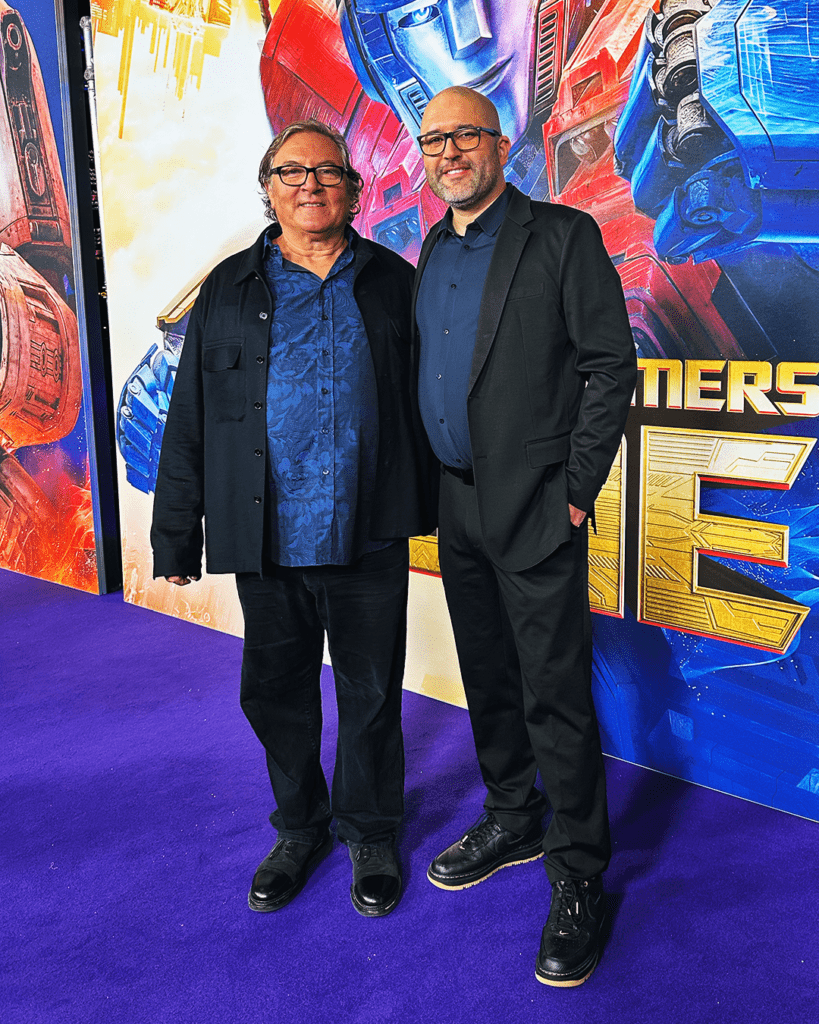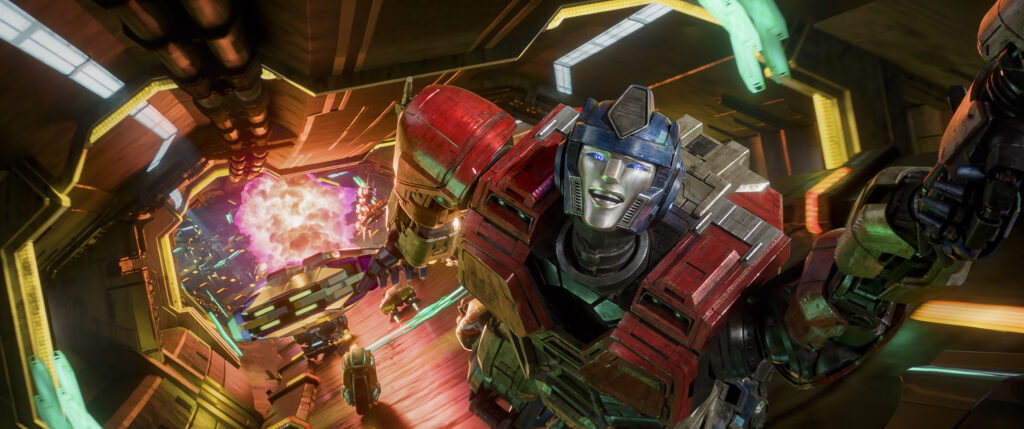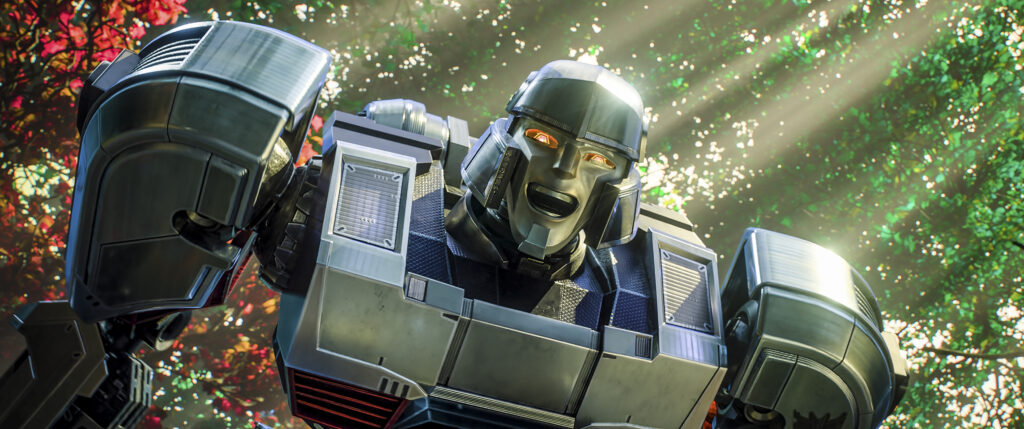By Kirsten Coachman
Before Optimus Prime and Megatron were the beloved “Transformers” characters as fans know them today, they were just everyday mining bots known as Orion Pax and D-16.
In the newest entry of the storied “Transformers” franchise, the fully CG-animated “Transformers One” takes fans to a time when the curious idealist Orion Pax (voiced by Chris Hemsworth) and straight-laced D-16 (voiced by Brian Tyree Henry) were working in the mines in Iacon City on Cybertron. Orion Pax’s unwavering desire to find the missing Matrix of Leadership sends him and his best bud on an unexpected adventure alongside the career-minded Elita-1 (voiced by Scarlett Johansson) and the just-excited-to-be-there B-127 (voiced by Keegan-Michael Key). What the bots discover alters everything they thought they knew about Cybertron.
“Transformers One” triumphs with bold and richly detailed visuals and highly engaging storytelling imbued with humor throughout. It brings the “Transformers” origin story to the forefront, laying out the fractures that lead to the demise of a valued friendship and the rise of two now-archnemeses.

At the helm of “Transformers One” is director Josh Cooley, who graduated from Academy of Art University’s School of Animation & Visual Effects with a B.F.A. in 2002. Following graduation, he was hired at Pixar Animation Studios as an intern. During his 18-year tenure at Pixar, he worked on films such as “The Incredibles,” “Up,” and “Soul.” In 2016, he garnered an Academy Award nomination for Best Screenplay for “Inside Out.” He later received an Academy Award in 2019 for his feature film directorial debut, “Toy Story 4.” His latest writing projects include the live-action adaption of “Malamander,” for Sony Pictures and a live-action “Tower of Terror” based on the theme park attraction for Disney and Johansson.
Art U News sat down with Cooley last month to learn more about his newest film, “Transformers One,” how “Transformers” inspired his career in animation early on, and what he learned from his time at the Academy that he applies to his work on a regular basis.
To start, congratulations on this film.
Thank you so much.
You’ve mentioned in previous interviews that your love of animation started with “Transformers.” What grabbed you about this particular series?
It started from Saturday mornings. So it was like “Transformers,” “G.I. Joe,” “Looney Tunes,” that whole Saturday morning experience. I think just the buildup of school all week and finally being able to eat cereal and watch television was just like the best. And when I saw animation, I was like, it’s like magic. I wanna do that, whatever that is. I didn’t know what it was. And then once I learned about it, and I told my parents I wanna be an animator, my parents, both being artists, were like, “Yeah, of course. What are you gonna do, be a doctor?” [Laughs.] I was fascinated by it, but then also just supported the entire way.
So this film gets to tell the origin story of these two beloved characters—Optimus Prime and Megatron—for the very first time. What does it mean for you as a storyteller to be the person who gets to do that?
Oh, wow. Well, it’s a huge honor. From day one, it was a huge responsibility because people know these characters and are so familiar with them. They grew up with them the same way I did. And so there’s a huge responsibility to make sure it feels right. That was a huge goal. But what made it easier was having a crew that wanted to do the same thing; they all grew up with it the same way I did. And some of them were even bigger fans. They knew even deeper cuts. I’ll put it this way. The fear was never there. It wasn’t like a daily thing of, “Oh no, are we doing this right?” It just became really fun. I think you feel that when you watch the movie.

I think so, too. Also, I love that there’s so much humanity in this story.
Because it’s on their home planet, there’s no humans involved. It allowed us to tell the most human story we’ve ever told with “Transformers” because they are our main characters. I felt like if the more that we can set them up as having this friendship from the very beginning, you know it’s gonna fall apart. And there’s always gonna be that underlying tension of when’s the other shoe gonna drop. Kind of playing off what people already know and love about these characters.
One of the scenes that stood out to me was the flashback sequence. I thought it was just beautiful and intriguing to learn about what had happened to the Primes and, ultimately, how it affected Orion Pax and D-16 in very different ways. Can you talk a little bit about the idea behind that sequence and what you wanted to accomplish with this scene?
Yeah, it’s one of my favorite scenes and it was a tough one. So it is a moment for [the characters] to learn some history that they didn’t know about. And the most boring way to tell that would be just to have a character stand there and talk about it. And so it was like, okay, this is a movie. We wanna make it visual. How do we do that? We can also just flash back to it, and it would be almost like this mini-movie that happens. But I was thinking the most intense way to experience it with the characters would be to put them in it. They’re in the room where it happened. And so let’s let it come to life in a way that’s almost like AR. That’s kind of what I was thinking about, like augmented reality and something like [a] holograms kind of a thing. Being that the Primes are magicals, let’s do it in a magical way. That was a way to kill two birds with one stone by having them in it. So we’re learning that information along with them, but then also able to easily see them react to it. That’s why we had a character fall through them and just make them part of it.
Working on a film at ILM (Industrial Light & Magic) is a dream job for animation students while in school. How was your experience working on the film there?
Surreal. I still can’t believe it. It was great. I mean, they’re the best for a reason. They’re fantastic. And they—same as my crew at Paramount—they’re huge fans, and a lot of them worked on the live-action [films], so they came with that knowledge as well. But, you know, it’s not the same exact type of movie. In the effects of the live-action of them transforming, for example, there are so many moving pieces and so much detail because you have to put that next to Shia LaBeouf, and it has to look real. We’re exaggerating everything. So it allowed us to have a little bit more freedom and just kind of push the scale of everything, and even our transformations are one-for-one, meaning the characters actually transform like the actual toy would.

I wanted to ask you about working with your cast, which is insanely stacked.
Yeah. [Laughs.]
With you also doing a little bit of voice acting, does that help guide you as a director in knowing what you want from your group of actors?
Absolutely. I think I’ve heard this before where the best thing you can do as a director is act ’cause you have to know what you’re asking your actors to do. You have to be very vulnerable. I mean, actors are very vulnerable. Because sometimes they just don’t see where you’re going yet. So not only have I done voice work, just for necessity of we don’t have time to get Chris Hemsworth right now. I’ll just do it quickly to get it up on the screen. There’s that version, but when I’m recording all the actors—we never recorded any of them together on this film just for scheduling purposes—I’m always reading opposite of them. I use it as a way to help direct because I’m not telling them exactly what to do, but they at least have something to play off of. Since we’re always recording in isolation, they have somebody to react to. And if I know in my head that this character on screen is about 10 feet away, then I make sure I raise my voice, and they just kind of naturally match it.
Was there somebody that you were surprised that came aboard this project?
The entire cast? I was pleasantly surprised by everybody’s knowledge of “Transformers.” I didn’t know what to expect, you know, everybody’s different backgrounds, different countries, and it’s a franchise that’s been around for 40 years, and so everybody has some sort of knowledge of it, which is really cool.

Being that “Transformers” first appeared in the ‘80s, but it’s also something that found a new life in the aughts and has continued to now with this origin story; is there more pressure to have this film appeal to longtime “Transformers” fans, or opening it up to a new audience?
To me, both are just as important. Because I wanted to make sure that this felt like “Transformers,” so nobody goes like, “Wait, what is this?” So, it took a while to find the tone. So that’s not just for people who are longtime fans who know the characters so well, but also an entry point for people who have never seen “Transformers” or don’t know the characters that well. You can come into this movie from the very beginning and learn everything right away and to come in completely fresh and still enjoy the movie just as much as a hardcore fan would.
Going back to your days at the Academy, is there something that you took from a certain class, whether skill or practice, that you still apply to your work today?
Every day. Every day. Because I was studying illustration in 2D animation at the Academy, so staging, silhouette value… just clarity, I feel, is the biggest thing. Whether it’s a drawing or whether it’s animation, whatever it is, just storytelling in general. Clarity, just making it clear what’s happening, is instrumental, especially on a movie where the planet’s made of metal and the characters are made of metal, and things are very detailed. It can get lost quickly. So I wanted the audience to always know what was going on, where they were, what the expression was. Even if your camera’s pulled back, I wanna make sure that you can just look at the body language. My only illustration classes were that, like figure drawing. Just seeing how you can tell the story of that character’s emotion from behind. So, I’m always thinking about everything that I’ve learned from these classes.
What is something that you would tell our animation students to have as a goal as they work through the semester?
Keep it simple. I remember as an animation student—you always wanna make something that wows everybody and is epic and huge. And I remember seeing friends of mine like, “I’m gonna animate all these horses running.” And it’s like, “No, you’re not, dude [laughs], you’re not gonna make it.” But just tell a very simple story. ‘Cause the simpler, the better.
“Transformers One” is now playing in theaters. This Q&A has been edited for length and clarity.
